Bruce Hoy
PNG Museum acquisitions 1978-1988
Bruce Hoy was curator of the Modern History Department (PNG War Museum) of the National Museum and Art Gallery (NMAG) between 1978–1988. Listing of key acuqisitions for the museum.
Richard Culton's P-39D 41-38351 Tail
The tail section of P-39D Airacobra 41-38351 was recovered 19
December, 1980, the day we were shown to it by an elderly
villager who had also brought Richard Culton into the village in 1943.
It was dismembered from the rest of the wreckage (only wiring
and a small section of stringers) and then manhandled onto
the back of my Datsun pickup truck and brought back to Moresby,
causing quite a bit of damage to the paintwork of my vehicle
in the process.
When we arrived in the village, I asked the
kids if they knew anything about an aircraft wreck close by.
They all said no, but one little fellow said that there was
one close by, he had not seen it, but his grandfather knew
all about it. The other kids then ridiculed him, and he went
running off to fetch his grandfather who was working in the
garden. Eventually, he returned with this wizzened old fellow,
who confirmed what his grandson had said, and related how
he had brought the pilot into the village, made him a cup
of tea to steady his nerves, and then await the arrival of
other Americans. He then led us to the crash site, and after
wandering away a little while, with me thinking he was senile,
there it was, barely 200 yards from the village! The reason
the kids did not know of it, was that normally, the water
and reeds covered the wreckage, and this was the first year
in memory when the swamp all but dried out.
The tail section and one propeller were recovered
and brought back to Port Moresby. We were still digging out
the 37mm cannon, but gave up. P-39D Airacobra 41-38351 was lying in the middle
of a swamp, and only about 150 yards from a village. Even
the kids did not know of its existence. We were shown to it
by an old man, whom we first though as being mad, as we were
told it was a mile or so from the village. You can imagine
everyone's surprise when we were shown it. The story about
Culton after his bail out was was told by the same old man
who showed us the wreckage. I since obtained a copy of the
report covering this action, which partially verified what
the old fellow had told me.
I have been reliably informed that this unique and special item has been sold in recent years by the museum to an enthusiast rebuilding a P-39. What a terrible shame when the accession card on this object clearly states its historical connection to the last major daylight attack on Port Moresby. Fortunately, sitting in my garage here in Australia, is the propeller blade from 41-38351 for which I was granted an export permit in 1988. So, there still is one remaining relic from the last major attack on Port Moresby. It is destined for a museum here in Australia.
|
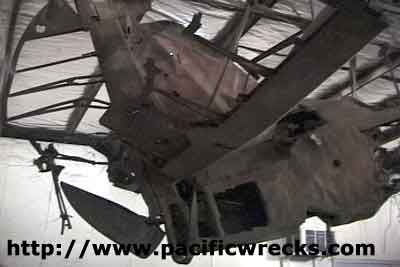
P-39D 41-38351 Tail
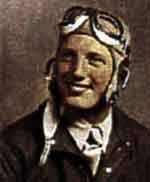
Richard Culton |
G4M1 Wreck Mt. Albert Edward
I have been to
this wreck [G4M1 Betty 1605] as the museum representative while a Japanese
party retrieved the remains of the tail gunner. Wednesday,
3 November 1982, landed. Set up camp, then walked down to
the crash-site. Back up to camp, over-night, and then lifted
out the next day. Saw no ghosts, but I came down with a terrible
migraine, possibly caused through the altitude and physical
excursion. The two Japanese that accompanied me were from
the Ministry of Health and Welfare they kept to themselves and did not appear interested with the museum's request to make contact with veterans.
I was later informed of the name of the
gunner, and that his loss occurred on 12 April 1943. Took
quite a few pictures of the wreckage. The fuselage from about
the trailing edge of the wing to the tail is lying between
two large boulders. It is not touching any ground, so it may
last for years and years without massive deterioration. The
aircraft was painted dark green with the lower section a blueish-white.
I came down with altitude sickness, and the walk back up to
our camp site was agonizing, with my head about to burst!
|
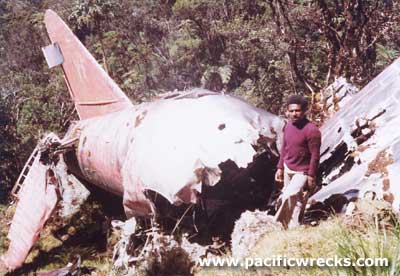
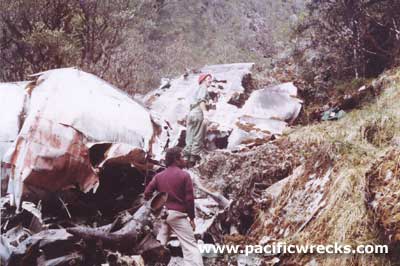
PNG
Museum 1982 |
Japanese Ki-61 Tony at PNG Museum
Roy Worcester
[who recovered Ki-61 Tony 299 in Wewak in the 1970's] had
painted his name on these bits with the expectation of having
them shipping back to Wewak. Roy never held a recovery licensed
for scrap in the Madang area, so I can only assume that
he was trying to do it on the sly at the time.
The Oscar bits and pieces came from Wewak
and were a part of Worcester's collection [Roy Worcester Historical Centre]. We were only
able to bring across a fraction of his material to Port
Moresby before the Defense Force encountered problems in
obtaining water at the wharf, and before we could get another
LCH back to Wewak, the port authority bulldozed the lot
into land fill. Just another gruesome episode.
My museum was swamped with lack of funds,
and we did not have anything available to have the stuff
shipped commercially. All that came was the cockpit section,
and I do not think I found a constructor's number anywhere
there.
However I did manage to recover a Ki-61 Tony 640 from the East Sepik Province through the assistance of the Royal Australian Air Force (RAAF) and the PNG Defence Force (PNGDF). It arrived in three sections, the single piece wing the engine and the fuselage minus the tail unit. A friend built a steel dolly on which the fuselage could be wheeled around inside the shed. This aircraft was later sent to Australia as part of an agreement entered into by the Museum for it to be rebuilt in Wangaratta in Victoria. As far as I am aware, the aircraft’s restoration has been completed [but never returned to PNG].
William F. Hanning's P-40E 41-36166
The intention of The Air Museum of Papua New Guinea was that
the P-40E 41-36166 was to got to David Tallichet, who would rebuild
it and then return it. Bill Chapman thought that Armstrong
had in fact recovered everything and that all had gone
to Chino. He only found out when the owner of the farm
came in one day and asked Bill when he was going to recover
the wings. It turns out that the fuselage did not end
up in Chino, but "elsewhere". Putting it mildly, The Air Museum was furious with this apparent misuse of
trust.
Door from Yamamoto's Crashed G4M1 Betty
I brought the door and seat [from Yamamoto's G4M1 Betty 2656] with me from The Air Museum of Papua New Guinea having been collected by Bill Chapman.
Radio Compartment Machine Gun from B-17E 41-2446
As was [collected by Bill Chapman] the .50 caliber machine gun that originally came off B-17E 41-2446 (aka "Swamp Ghost").
Tail of B-24D "Weezie" 42-41081
The tail off B-24D "Weezie" 42-41081 was one of the highlight
displays - quite a job bringing it off the mountain in
the last helicopter lift. It was the slowest chopper flight
I have experienced, as even though we had weighted the
net with rucksacks and a 50 calibre gun, it was still
really too light. But we did make it, and I guess the
museum owes CIL a vote of thanks, as that flight would
have cost them treble what it should have. It soon became an item of deep interest through local and overseas visitors the only surviving “Skull and Crossed Bombs” tail marking from the 90th Bombardment Group in a museum.
P-38 Lightning at the Museum
P-38F 42-12647, recovered in November
1978. Was assigned to the 39th Fighter Squadron, and
originally the mount of Ralph C Bills. Last known flight
was on 14 May 1943 when Wayne Rothgeb took off to intercept
Zeros approaching Dobodura. The right turbo-charger
exploded, and Rothgeb made an emergency landing at 14
Mile Drome near Port Moresby. Aircraft subsequently repaired,
and lost at a later date, possibly in early 1944.
P-47 Cockpit section (formerly) at the Museum
P-47D "Frankie" 42-8130 cockpit section was
restored by a museum in New Zealand [Museum of Transportation and Technology MoTaT). This was "Frankie"
used by Capt S V Blair.
|
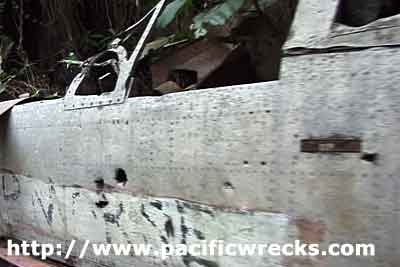
Ki-61 Tony Fuselage
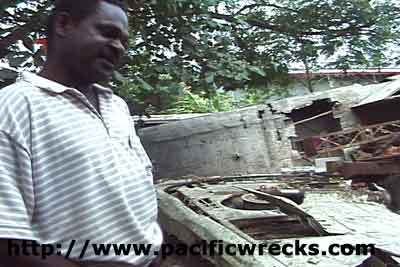
P-40 Wings

Yamamoto Door

.50 caliber machine gun
from B-17E 41-2446
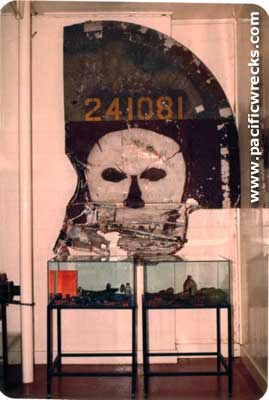
B-24 Tail
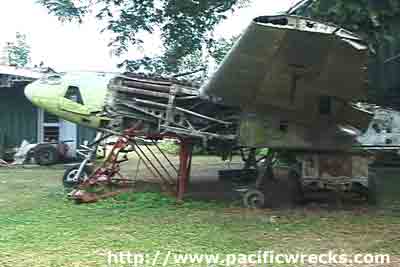
P-38F 42-12647

P-47 "Frankie" 42-8130 |
B-17E "Naughty But Nice" 41-2430
Jose Holguin and his pilot Hal Winfrey
visited PNG in 1981. I became aware after the visit,
and we struck up friendly exchange of letters. Holguin
decided to make another visit to PNG to try and find
his aircraft. He arrived in Port Moresby on 21 July
1982 and while there, I toured him on several occasions
around Port Moresby. I guided him to the location for the 65th
Bomb Squadron Officer's Club, as well as the 65th Enlisted
Men's Club, and found the approximate location of his
tent.
He flew to Rabaul on or about 25 July,
my wife, daughter and I then flew to Rabaul on 27 July
and met up with he and Brian
Bennett. I had copies of the Missing Aircraft Report,
and with Brian, we tried to ascertain where B-17E "Naughty But Nice" 41-2430 could be located. In the meantime, Brian had tracked down the
village that Holguin had ended up in, and located the
family who had nursed his wounds. They were taken to
one B-17 crash site, but that turned out to be a B-17F.
After my arrival, we decided to pool our resources and
fly into the village mentioned in the 1948 report. This
we did on 29 July, landing at Wusing Village.
We then hiked to Leming Village, crossing a river on our way. In Leming, we found several young fellows who knew where an aircraft was lying. Spending the night in a smoky hut with about three families, I was glad when sunrise came, and I was able to exit that smoky environment. We set off the next morning at about 6am, and walking mostly down-hill, we decided to call it quits at 8.45am,
as we had been continually told that the wreckage was
"close". We decided to walk until 9am and
if the river that was supposed to be close to the wreckage
was not reached by then, we would turn back to the village.
Well, promptly at 9am, a river was reached, and we crossed
it, sending the villagers out to scout out the aircraft.
They returned after about 20 minutes, and we were then
guided to the wreckage, the first part being a large
squashed item. On inspecting this item, I realised it was part of the cockpit and most of the forward nose section. I then noticed what looked like artwork. Using two poles,
Brian levered up the wreckage and Holguin and I were
able to see the artwork and nickname. [This relic is
now on display at the Kokopo
War Museum]
We then spent a little while there, and I had to forcefully restrain Holguin from digging in the cockpit nose area for anything from the bombardier, as he was in danger of disturbing the site that had yet to be fully investigated. He retrieved a Colt .45 which I permitted Holguin to keep as he wanted to give it to the widow of bombardier 1st Lt. Francis G. Peattie. We then walked down the slope and stumbled across the rear fuselage resting on the edge of a small creek. On not seeing the tail section, we were at a loss as to what had become of it. Holguin had told us that after he had landed, he slid down the slope, found the fuselage and tail section, and the dead tail gunner, and tried to reach in and remove his boots as he had lost his. He then saw the ball turret gunner, badly consumed by fire, still in his turret. Not seeing the tail, we just assumed that the only conclusion was that the Jaspanese had carried it out as a trophy. I found the tail section 300 metres away in 1984, and the ball turret was also discovered in many pieces, none of which having been damaged by fire, so Holguin’s memory was either distorted from the events he had experienced, or simply that he came down nowhere near the wreckage of his aircraft.
We then walked back to the river, and Brian set off up the hill to Leming Village where the chopper was to have collected us, leaving Holguin and I trying to keep dry from a sudden tropical down pour. The chopper with Brian arrived several hours later and whisked us back to Rabaul. Although Joe had his camera, I took many with mine, which I subsequently gave him some copies.
Recovery of Remains
An American recovery team in 1948
recovered what they thought were two individuals. These
were exhumed in 1983 and deemed to have been either
four or five individuals. The first CILHI recovery took
place in 1983, after Holguin had ripped up half the
jungle in extracting the cockpit section. Then another
in 1984, during which I found the tail section 300 metres
from the rear fuselage, and Brian found the wing and
bomb-bay section. Then it was last visited in 1986.
Return to Bruce Hoy Interview Main Page |

Cockpit Bruce Hoy 1982

US Star Bruce Hoy 1982

Nose Art
Bruce Hoy 1982

Brian Bennett with Nose Art
Bruce Hoy 1982
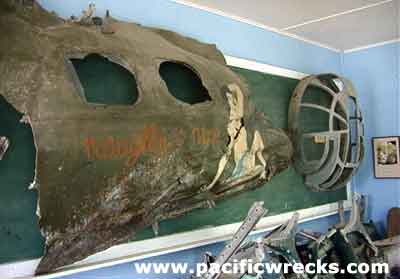
Nose art & Top Turret
in Kokapo
Museum
Justin Taylan 2000
|
|